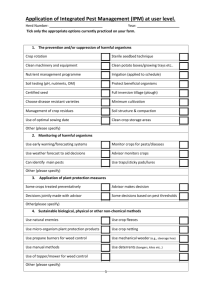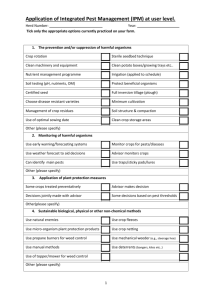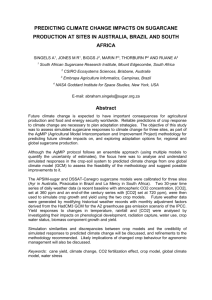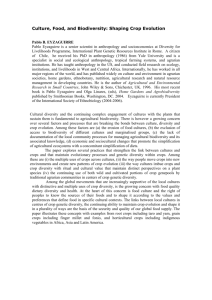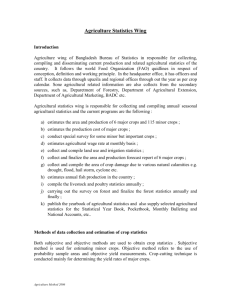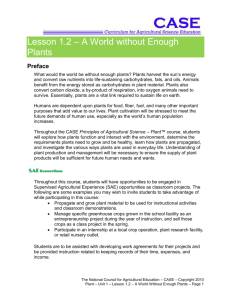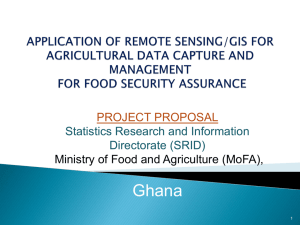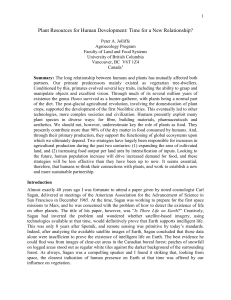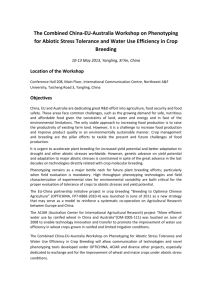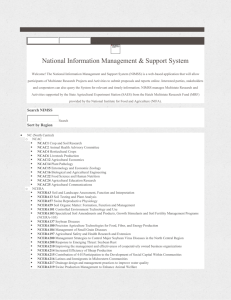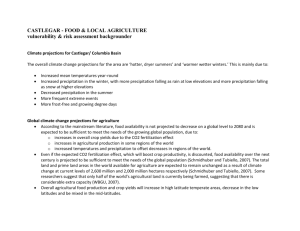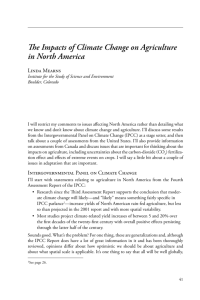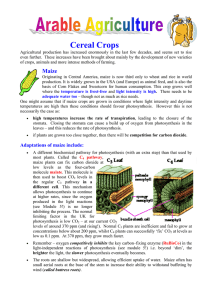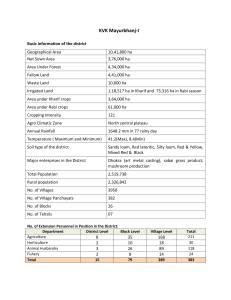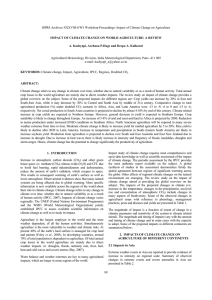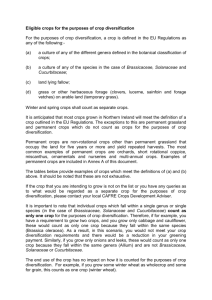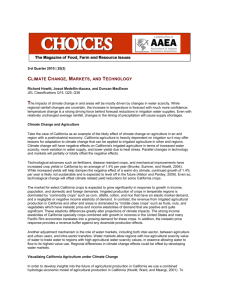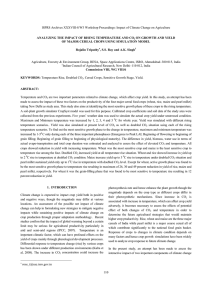Impact of climate change in Indian Agriculture
advertisement
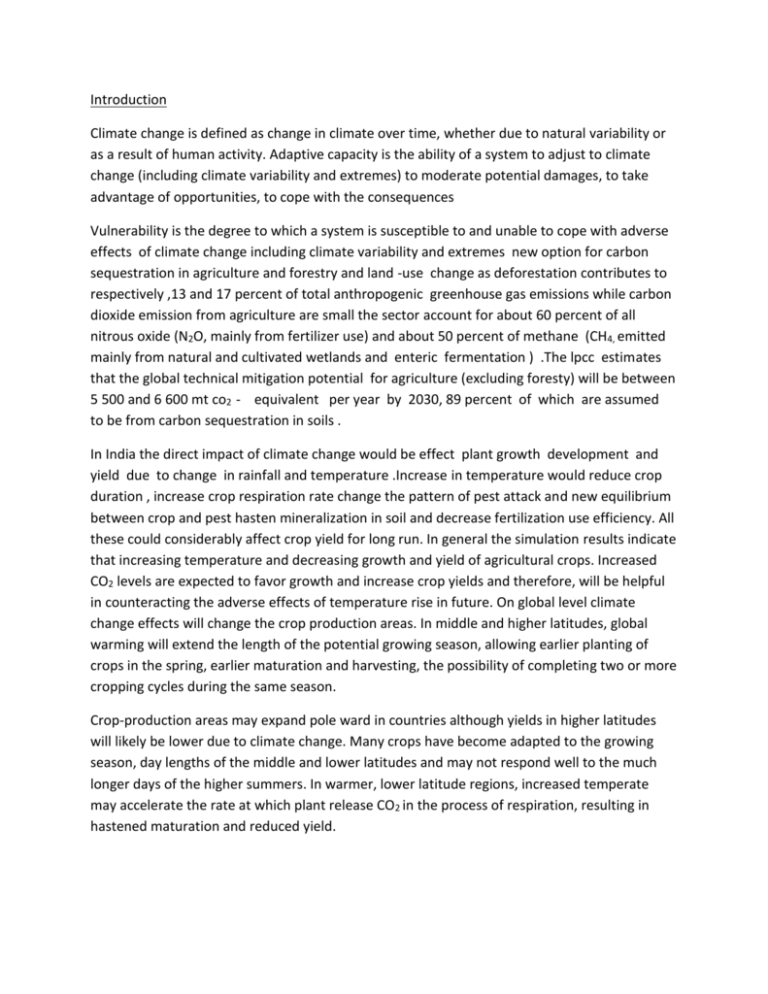
Introduction Climate change is defined as change in climate over time, whether due to natural variability or as a result of human activity. Adaptive capacity is the ability of a system to adjust to climate change (including climate variability and extremes) to moderate potential damages, to take advantage of opportunities, to cope with the consequences Vulnerability is the degree to which a system is susceptible to and unable to cope with adverse effects of climate change including climate variability and extremes new option for carbon sequestration in agriculture and forestry and land -use change as deforestation contributes to respectively ,13 and 17 percent of total anthropogenic greenhouse gas emissions while carbon dioxide emission from agriculture are small the sector account for about 60 percent of all nitrous oxide (N2O, mainly from fertilizer use) and about 50 percent of methane (CH4, emitted mainly from natural and cultivated wetlands and enteric fermentation ) .The lpcc estimates that the global technical mitigation potential for agriculture (excluding foresty) will be between 5 500 and 6 600 mt co2 - equivalent per year by 2030, 89 percent of which are assumed to be from carbon sequestration in soils . In India the direct impact of climate change would be effect plant growth development and yield due to change in rainfall and temperature .Increase in temperature would reduce crop duration , increase crop respiration rate change the pattern of pest attack and new equilibrium between crop and pest hasten mineralization in soil and decrease fertilization use efficiency. All these could considerably affect crop yield for long run. In general the simulation results indicate that increasing temperature and decreasing growth and yield of agricultural crops. Increased CO2 levels are expected to favor growth and increase crop yields and therefore, will be helpful in counteracting the adverse effects of temperature rise in future. On global level climate change effects will change the crop production areas. In middle and higher latitudes, global warming will extend the length of the potential growing season, allowing earlier planting of crops in the spring, earlier maturation and harvesting, the possibility of completing two or more cropping cycles during the same season. Crop-production areas may expand pole ward in countries although yields in higher latitudes will likely be lower due to climate change. Many crops have become adapted to the growing season, day lengths of the middle and lower latitudes and may not respond well to the much longer days of the higher summers. In warmer, lower latitude regions, increased temperate may accelerate the rate at which plant release CO2 in the process of respiration, resulting in hastened maturation and reduced yield. Available Water Agriculture of any kind is strongly influenced by the availability of water. Climate change will modify rainfall, evaporation, runoff, and soil moisture storage. Changes in total seasonal precipitation or in its pattern of variability are both important. The occurrence of moisture stress during flowering, pollination, and grain-filling Is harmful to most crops and particularly so to corn, soybeans, and wheat. Increased evaporation from the soil and accelerated transpiration in the plants themselves will cause moisture stress; as a result there will be a need to develop crop varieties with greater drought tolerance. Pests and diseases Conditions are more favorable for the proliferation of insect pests in warmer climates. Longer growing seasons will enables insects such as grasshopper to complete a greater number of reproductive cycles during the spring, summer, and autumn. Warmer winter temperatures may also allow larvae to winter over in areas where they are now limited by cold, thus causing greater infestation during the following crop season. Altered wind patterns may shift as the timing of development stages in both hosts and pests is altered. Live stocks diseases may be similarly affected. The possible increases in pest infestations may bring about greater use of chemical pesticides to control them, a situation that will require the further development and application of integrated pest management techniques. Sustainability and food security Climate change can impact agricultural sustainability in two interrelated ways: first, diminishing the long-term ability agro-ecosystems to provide food and fiber for the world’s population; and second, by inducing shifts in agriculture regions that may encroach upon natural habitats, at the expense of floral and faunal diversity. Global warming may encourage the expansion of agricultural activities into regions now occupied by natural ecosystem such as forests, particularly at mid- and high-latitudes. Forced encroachments of this sort may thwart the process of natural selection of climatically-adapted native crops and other species. While the over-all, global impact of climate change on agricultural production may be small, regional vulnerabilities to food deficits may increases, due problems of distribution and marketing food to specific regions and group of people. For subsistence farmers and more so for people who now faces a shortage of food, lower yields may results not only in measurable economic losses but also in malnutrition and even famine. In general, the tropical regions for several reasons. On the biophysical side, temperature C3 crops are likely to be more responsive to increasing levels of CO2. Second, tropical crops are closer to their high temperature optima and experience high temperature stress, despite lower projected amounts of warming. Third, insects and diseases, already much more prevalent in warmer and more humid regions, may become even more widespread. Inferences 1. 2. 3. 4. 5. Co2 is increasing CH4 is increasing Earth atmosphere system temperature and surface temperature is increasing Extreme temperature increasing Atmospheric water vapors content increasing. Frequency of heavy precipitation events increasing 6. More intense and longer droughts 7. Mid-latitude wide patterns/ storms tracks shifting pole ward. 8. Tropical cyclone intensity increasing. 9. Area of seasonally frozen ground decreasing 10. Glaciers and snow cover decreasing, Arctic sea ice extent decreasing. Conclusion 1. Plantation should be increasing on the foot of Himalaya, Sahyadri ranges, costal area and barren land. With reference to Gujarat forest area should increase from9.5% to 20% in next decade or by 2020 AD. 2. For controlling methane emission from the paddy field, the appropriate water saving technology should be used instead of transplanting and submerged paddy cultivation method. 3. Shelter belts should be created near sea shore to check salinity and salt nuclei in atmosphere, which changes rainfall pattern. 4. The simulation results indicate that increasing temperature and decreasing solar radiation levels pose a serious threat in decreasing growth and yield of agricultural crops. Increasing CO2 levels are expected to favor growth and increase crop yields and therefore, will be helpful in counteracting the adverse effects temperatures rise in future.

